Order these records by:
Browse Collection › Printed Works › 22 records found where Category is pw | ||
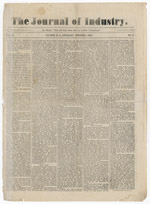 | Oration on the occasion of the Second Annual Exposition of the Colored People of North Carolina, delivered on October 1, 1880 Frederick Douglass delivered this “Oration on the occasion of the Second Annual Exposition of the Colored People of North Carolina” in Raleigh, North Carolina on October 1, 1880. Douglass offered his vision of economic progress for black farmers living in the South. Charles Hunter, editor of the Journal of Industry reprinted the oration in his newspaper and included other news stories about the Exposition. | |
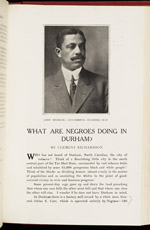 | What are Negroes doing in Durham? Essay by Clement Richardson in the Southern Workman highlighting the achievements of the African American community in Durham in the early 1910s. Richardson focuses on the contributions of black entrepreneurs and professionals including E. R. Merrick, Robert Fitzgerald, Stuart Lynn Warren, John Merrick, Dr. A. M. (Aaron McDuffie), R. H. Clegg, W. G. Pearson, J. S. Scarborough, E. W. Cannady, Dr. F. D. Page, Peyton H. Smith, P. W. Dawkins, Jr. and others. | |
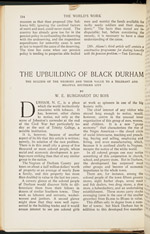 | Upbuilding of black Durham: the success of the Negroes and their value to a tolerant and helpful southern city Essay by W. E. B. DuBois in the World's Work reporting on his visit to Durham, North Carolina in 1912. DuBois analyzes the economic culture and explores the history of race relations in this southern city. DuBois provides a history of black enterprises and educational institutions that served the black community in Durham. The article features photographs of R.B. Fitzgerald, C.C. Spaulding, White Rock Baptist Church, North Carolina Mutual Insurance Company and a view of workers in a black-owned hosiery manufacturing company. | |
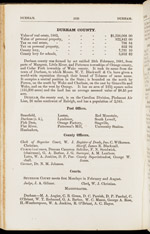 | North Carolina state directory and gazetteer, 1883-84 (Excerpt) Section of Chataigne's 1883-1884 gazetteer listing the names of merchants, business owners, and tradesmen in Durham County, categorized by occupation. The directory also provides information about public officials and the location of post offices. | |
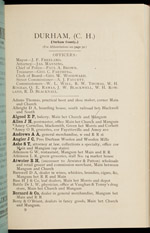 | Chas. Emerson’s North Carolina tobacco belt directory 1886 (Excerpt) This section of Emerson's 1886 directory lists businesses within the corporate limits of the town of Durham.The directory lists the names of proprietors, stores' locations and the products sold. Individuals with African American heritage are denoted by an asterisk (*). | |
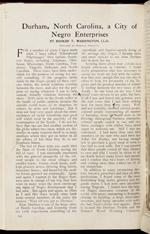 | Durham, North Carolina, a city of Negro enterprises Booker T. Washington, principal of Tuskegee Institute, penned this essay in 1911 for the illustrated magazine, Independent. Washington, recounts his travels to Durham and gives his observations about race relations in Durham. Washington discusses the economic and cultural contributions of many prominent members of the African American community including: Richard B. Fitzgerald, Aaron M. Moore, Richard E. Clegg, John Merrick, and Charles Clinton Spaulding. He devotes much of his analysis to the economic development of the black community in a place that he dubbed, “City of Negro Enterprises.” | |
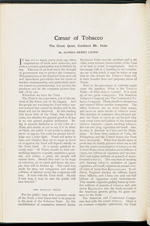 | Caesar of tobacco : the great, quiet, confident Mr. Duke Biographical portrait of James Buchanan Duke, with a focus on his leadership role in the American Tobacco Company and the Continental Tobacco Company. | |
 | Chas. Emerson’s North Carolina tobacco belt directory 1886 (Excerpt) This excerpt from the 1886 directory lists Durham County's land owners. Each entry includes the landowner's name, the location of the nearest post office, and the number of acres the individual owned. Individuals with African American heritage are denoted by an asterisk (*). The directory identifies 16 post offices in Chapel Hill, Dayton, Durham, Fish Dam, Flat River, Hillsboro, Kunkadora, Luster, Lyndover, McCown, Morrisville, Mount Tirzah, Orange Factory, Red Mountain, Staggville, and South Lowel. Advertisers include John L. Markham; Robertson, Lloyd and Co.; and the Durham Recorder. | |
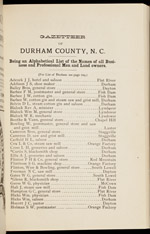 | Chas. Emerson’s North Carolina tobacco belt directory 1886 (Excerpt) This section of the 1886 directory entitled, Gazetteer of Durham County, North Carolina, lists 70 Durham County merchants and land owners, together with the name of the post office located nearest their businesses. Individuals with African American heritage are denoted by an asterisk (*). Occupations include hotel and saloon keeper, shoe maker, general store keeper and grocer, postmaster, mechanic and blacksmith, minister and pastor, saw and grist mill owner, physician, and cotton ginner. | |
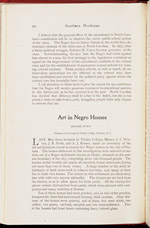 | Art in Negro homes Essay by Trinity College professor Jerome Dowd (1864-1952) describing a survey made by three Trinity College students in the early 1900s of the interiors and exteriors of 25 homes in Hayti, a largely African American community in Durham, North Carolina. The article enumerates the material cultural artifacts--decorative art, carpets, and furnishings--in these homes as well as the titles of books, magazines and newspapers. | |
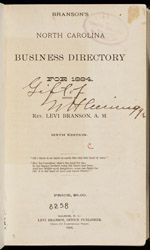 | Branson's North Carolina business guide This section of the guide contains physical attributes, land values, livestock values, taxes, and population statistics for Durham County. Branson notes that Durham County's population was 13,000, of which 8,500 were white and 4,500 were black. Also provided are the towns that had a post office, as well as county officers, court hearings, townships, magistrates, churches, pastors, and denominations. For individuals, Branson lists the name, nearest post office, and occupation. Edward James Parrish and Blackwell's Warehouse bought advertising space in the guide. | |
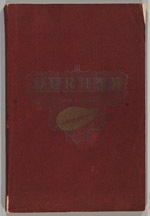 | Hand-book of Durham, North Carolina : a brief and accurate description of a prosperous and growing southern manufacturing town This pocket-sized handbook documents the people, businesses, social conditions, and government of Durham, North Carolina, and compares Durham's industrial and social advantages to other cities of the same size. It includes statistical records and information about Durham's government, health, real estate, taxes, buildings, streets, waterworks, fire departments, electric lights and gas, telephones, hotels, hospitals, markets, schools and colleges, churches, lodges, and social clubs. Included are lithographs of Mangum Street and Main Street and depictions of prominent buildings, such as: Bennett Place; Durham County Court House; the Fire House; Hotel Carolina; City Hospital; Durham Graded School; Trinity College's Main Building; Trinity Methodist Church; Main Street Methodist Church; the Presbyterian Church; the First and Second Baptist Church; bank buildings; the factory of the Blackwell Durham Tobacco Co.; Duke Tobacco Factory; and textile factories. Portraits include Isaac N. Link, ma... | |
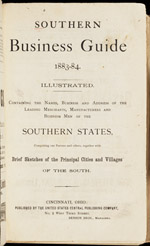 | Southern business guide, Section of the 1883-84 Southern Business Guide containing the personal names, business names, and street addresses of the leading merchants, manufacturers, and businessmen of Durham, North Carolina. Also provides a summary of Durham's history and railroad lines. The guide lists 71 businesses and their locations. | |
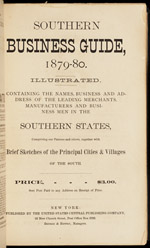 | Southern Business Guide (Excerpt) This section of the Southern Business Guide 1879-1880 contains the names of the leading merchants, manufacturers, and entrepreneurs of Durham, North Carolina. The guide lists, in alphabetical order, 54 businesses. Includes listings for businesses on Main Street as well as W. Duke, Sons and Company, Atlas Rigsbee's General Store, R. H. Wright & Company and W. T. Blackwell & Company. | |
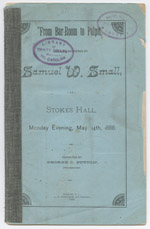 | From the bar-room to pulpit: lecture delivered by Samuel W. Small at Stokes Hall, Monday evening, May 14th, 1888 A prohibition lecture delivered at Stokes Hall, Durham by Atlanta evangelist Samuel Small. Small recollects his encounters with Sam P. Jones and his personal conversion from drunkard to prohibitionist. | |
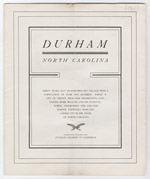 | Durham, North Carolina : thirty years ago an insignificant village with a population of some five hundred A Durham Chamber of Commerce booklet, published in 1906, which presents a short history of Durham as well as numerous photographic illustrations of educational institutions, churches, manufacturing establishments and street scenes. The pamphlet also includes statistical information about Durham County and its schools. | |
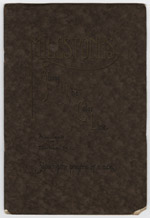 | Milestones along the color line. A souvenir of Durham, North Carolina showing the progress of a race Oliver B.Quick created Milestones Along the Color Line. A Souvenir of Durham, North Carolina Showing the Progress of a Race, to show property “owned and controlled exclusively by Negroes in the city of Durham, N.C.” In his preface he noted, “we have selected these [institutions and homes] as evidence of the progress being made by our race group in this section of the South.” The pamphlet contains numerous photographic images of churches, schools, business establishments, private residences and street scenes. | |
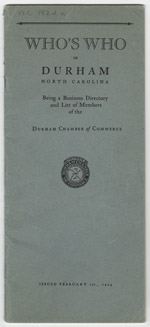 | Who's who in Durham, North Carolina ,being a business directory and list of members of the Durham Chamber of Commerce This 1924 Durham Chamber of Commerce publication contains information about the Chamber and its membership. The pamphlet provides an alphabetical listing of individual members, a classified business directory, and a section of “facts about Durham.” | |
 | Ordinances and resolutions for the government of the town of Durham, 1873 This 1873 pamphlet records laws for Durham's citizens and visitors. Includes prohibitions on cockfighting, littering, indecent exposure, and firing guns within town limits. Julian S. Carr held the post of mayor of Durham. Edward James Parrish, J. E. Lyon, J. F. Freeland, W. Mangum and James S. Lockhart served on the Durham Board of Commissioners. | |
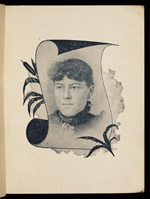 | My thoughts : A book of poems. With an introduction by James E. Shepard. M. Pauline Fitzgerald, one of Durham’s first African American school teachers, penned this self-published book of poetry. Pauline’s poetry memorializes Frederick Douglass, Dr. H. M. Tupper, founder and first president of Shaw University, and Bishop Daniel Payne of the A.M.E. Church. The collection also includes some more personal pieces including “An Ode to the First Colored Drug Store in Durham, North Carolina” and “The School Mistress.” Pauli Murray, author of Proud Shoes: The Story of an American Family relates a number of stories about her “Aunt Pauline” in her biographical account of M. Pauline Fitzgerald’s parents, Robert G. and Cornelia Fitzgerald. | |
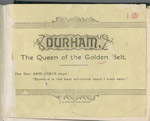 | Durham, the queen of the golden belt An pamphlet created by Durham Consolidated Land and Improvement Company to promote investment in businesses and real estate in Durham, North Carolina. Includes three lithographs of buildings in Durham: Main Building at Trinity College; West End Cotton Factory; and Wescarr Knitting Mill. Durham is described as a sophisticated town with well-developed industrial, commercial, and residential districts for: plants, mills, factories, railroad stations and tracks, banking facilities, schools, churches, and colleges. | |
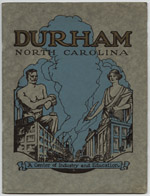 | Durham, North Carolina, a center of education and industry A Durham Chamber of Commerce booklet published in 1926, Durham, North Carolina, a Center of Education and Industry presents the "story of Durham's rise to a self-conscious power in the progress of the New South." Descriptions highlight Durham's crops, manufacturing, churches, businesses, housing and recreational facilities. Includes more than 35 pages of photographs with captions and an architectural rendering of a planned suburb in the Hope Valley area of Durham. | |
digitaldurham@duke.edu · About this site · Copyright © 2001 - 2006. Trudi J. Abel. All Rights Reserved.
The copyright interest in the material in this digital collection has not been transferred to the Digital Durham project. These text and images may not be used for any commercial purpose without the permission of the David M. Rubenstein Rare Book & Manuscript Library and the Digital Durham Project. Copyright permission for subsequent uses is the responsibility of the user.
